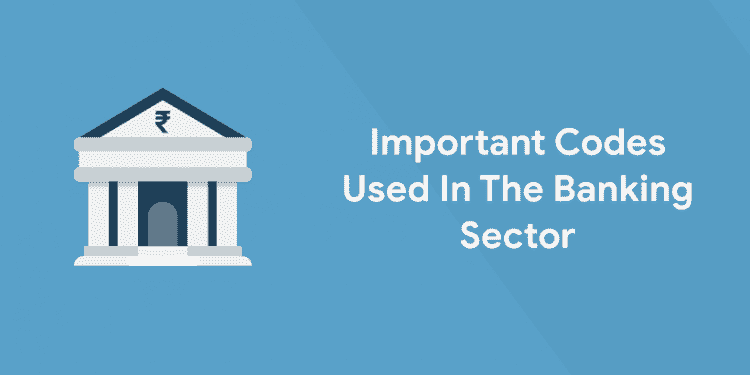Table of Contents
A job in the banking sector is a much coveted one. The number of aspirants for a job in this sector is increasing per year. Exhale a sigh of relief once you get a job but prepare yourself for what is yet to come. Once you land a job in the banking sector, prepare yourself to learn a lot of new terms and codes related to banking. Here is a list of some of the important codes used in the banking sector.
12 Important Codes Used in the Banking Sector
Here are the 12 important codes used in Banking Sector.
1. IFSC Code
IFSC stands for Indian Financial System Code. It is a unique 11-digit alphanumeric code. This code can be found in the cheque book provided by the bank and also on the front page of account holder’s passbook. The code for each branch is assigned by the Reserve Bank of India (RBI). IFSC code is used as an identification of a particular branch of a bank. It helps in solving any discrepancies in the money transfer process. It makes electronic mode of money transfer easy. In an IFSC Code, the first four characters are the alphabets denoting the bank name. The fifth character will be a zero. The remaining six characters are digits that denote the branch code, which makes the IFSC Code unique. For example, SBIN0070238.
2. PAN
PAN is the acronym for Permanent Account Number. It is a 10-character alphanumeric unique identifier. The first five characters are letters followed by four numerals and the last character is a letter. It is issued in the form of a laminated card by the Income Tax Department. It is an electronic system through which all tax related information of a person or a company is recorded. No two people can have the same PAN number as it is used throughout the country. There are different types of PAN Card: Individual, Hindu undivided family, company, partnerships or firms, trusts, society and foreigners. The main purpose of the PAN is to bring a universal identification to all financial transactions and to prevent tax evasion by keeping track of monetary transactions, especially those of high-net-worth individuals who can impact the economy. For example, AAECC6548C.
3. AADHAR
It is a 12-digit code issued to the Indian Citizens by the Government. The number serves as a source of identifying the person and address, anywhere in India. It is biometric and demographic proof of a person. It is provided by the Unique Identification Authority of India (UIDAI) and is a biometric ID system. For example, 1111 2222 3333.
4. PRAN
It stands for Permanent Retirement Account Number which is a 12-digit unique code issued to the central and state employees to receive their pension under the National Pension System (NPS).
5. MICR
MICR stands for Magnetic Ink Character Recognition. It is a 9-digit code. The starting 3 digits of the code is the city code, the next 3 digits are for the bank code and the last 3-digits stands for the branch code. It makes sure of the authenticity of the legality and credibility of paper-based documents in the banking database. MICR can be found on cheques at the bottom. It is a highly advanced technology used by banks to verify cheque clearances. For example, 6234567890.
6.BSR
BSR is the acronym for Basic Statistical Returns. It is 7-digit code and is allotted to the banks by Reserve Bank of India. It is not common for all the banks, instead each branch has a BSR code. For example, 305066.
7. SWIFT
It stands for Society of Worldwide Interbank Financial Telecommunication which is an 8-11 alphabetic code. This code is used to identify the bank all over the world and is approved by International Organisation for Standardisation (ISO)
8. UAN
UAN stands for Universal Account Number. It is a 12-digit number generated by Employees Provident Fund Association and is assigned to the owner of an Employees Pension Fund (EPF) account. It helps the employee to connect his PF across organisations.
9. TAN
It stands for Tax Deduction and Collection Account Number. It is a 10-digit alphanumeric code which is issued as per a person’s requirement to deduct tax at source TDS or to collect tax at source. TCS under Income Tax Act.
10. ISIN
ISIN is the acronym of International Securities Identification Number. It is a 12-digit alphanumeric series. It is an international numbering system developed by International Organisation for Standardization (ISO) and is used worldwide to identify certain securities such as bonds, stocks etc. The first 2-digits represent country code, next 9 digits is the unique identification number for security, and the last 9 is check digit. For example, INA022B09972
11. LEI
It is a 20-digit alpha numeric code and stands for Legal Entity Identifier. It is also developed by International Organisation for Standardization. The role of this code is to improve accuracy and quality of financial data systems for better risk management.
12. MMID
MMID stands for Mobile Money Identifier, which is a 7-digit number of a bank customer. This number is used when the customer tries to send or receive money using IMPS method. The MMID number for each of your bank account will be different.
Here are some of the banking terms and its definitions that you need to know while appearing for a banking exam or interview. Prepare well with Team Entri for banking exams and score well. Good luck!












